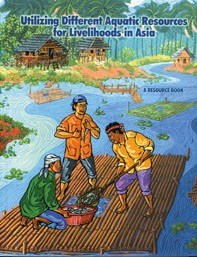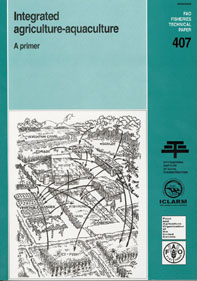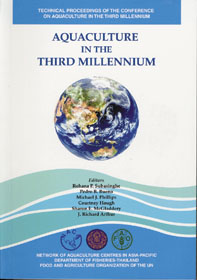
IIRR, IDRC, FAO, NACA and ICLARM 2001. Utilizing different aquatic resources for livelihoods in Asia: a resource book. International Institute of Rural Reconstruction, International Development Research Centre, Food and Agriculture Organizatiuon of the United Nations, Network of Aquaculture Centers in Asia-Pacific and International Center for Living Aquatic Resources Management. 416 pp.
This resource book which is complementary to the FAO/ICLARM/IIRR Integrated Agriculture Aquaculture: a primer consists of a compilation of reviews and proven experiences from Asia that are totally field-derived. It contains 67 contributions in 5 sections covering general issues and principles, participatory approaches and extension strategies and community-managed aquatic resources, and providing a wide range of lessons and experiences from freshwater, brackish water and marine systems.
FAO/ICLARM/IIRR. Integrated agriculture-aquaculture: a primer.
FAO Fisheries Technical Paper No. 407. Rome, FAO. 2001. 149 pp.

This document is an edited and slightly revised version of a previously published integrated agriculture-aquaculture (IAA) technology information kit. It contains 38 contributions in seven sections, outlining the basic issues and characteristics of IAA systems and making generous use of pictorial drawings and visual representations.
Socio-cultural, economic and environmental considerations in introducing IAA technologies are presented in the first four contributions. This section is followed by an overview of integrated farming systems, with six examples provided, ranging from integrated grass-fish and embankment-fish systems in the People’s Republic of China, over the VAC system in northern Viet Nam to short-cycle methods in seasonal ponds and ditches in Bangladesh. The next section has four papers dealing with livestock-fish integration of chicken-, duck- and pig-based systems. Two sections with a total of 16 presentations tackle several aspects of rice-fish systems, starting with eight technical examples from five countries, including irrigation systems, and in coastal areas with shrimp and in freshwater areas with prawn. Eight more presentations give recommendations on site selection, ricefield preparation, fish stocking, feeding, rice management and integrated pest management issues within rice-fish culture. Another section with four papers deals with aspects of fish feeding and management in IAA, such as the use of animal manure, domestic sewage and bio-gas slurry in ponds, as well as plant sources as fish feed. The last section contains four contributions on fish breeding and nursing, focusing on fry and fingerling production and emphasizing carp species. This includes a description of carp spawning in wheat fields and fry nursing in rice fields as off-season activities, as well as fry-to-fingerling rearing in rice fields.
This primer aims to give decision-makers in governmental and non-governmental organizations and in other organizations concerned with agriculture and rural development an overview and a basis for understanding the principles of IAA, and to help them decide whether to embark on IAA activities and include these in their program portfolio. For those who work directly with farmers, this primer aims at providing good examples of IAA, but it is not intended to be a compilation of procedures that should be strictly followed. Rather, this primer should help convince its readers/users that farmers can improve their livelihoods by either introducing IAA, or by further developing and improving the many IAA opportunities on their existing farms within their communities.
Subasinghe, R.P., Bueno, P., Phillips, M.J., Hough, C., McGladdery, S.E. & Arthur, J.E. (Eds.) Aquaculture in the Third Millennium - Technical Proceedings of the Conference on Aquaculture in the Third Millennium, Bangkok, Thailand. 20-25 February 2000. NACA, Bangkok and FAO, Rome. 471 pp.

FAO and the Network of Aquaculture Centres in Asia-Pacific (NACA) are pleased to announce Aquaculture in the Third Millennium, the Technical Proceedings of the Conference on Aquaculture in the Third Millennium. The Technical Proceedings represents the most comprehensive and authoritative review of the status of aquaculture development in the world assembled to date.
Over the past three decades aquaculture has expanded, diversified, intensified and advanced technologically and, as a result, its contribution to aquatic food production has also increased significantly. Aquaculture is highly diverse but a large proportion of production comes from small-scale producers in developing countries and Low Income Food Deficit Countries (LIFDCs). It significantly contribute to food security, poverty alleviation and social well-being in many countries. The contributions of aquaculture to trade, both local and international, have also increased over the past decades, and its share in the generation of income and employment for national economic development has also increased globally. The two landmark events in the recent history of aquaculture are the holding of the FAO Technical Conference on Aquaculture in Kyoto, Japan in 1976 and the Conference on Aquaculture in the Third Millennium held in Bangkok, Thailand, in February 2000.
The Conference on Aquaculture in the Third Millennium, which attended by 540 people from 66 countries, focused on the issues pertaining to the development of aquaculture and allied industries, and was conceived as a futuristic exercise to envision the state of aquaculture in the third millennium and to formulate strategies for national, regional and inter-regional actions. The Technical Proceedings of the Conference, "Aquaculture in the Third Millennium" represents the most comprehensive and authoritative review of the status of aquaculture development in the world assembled to date. The Technical Proceedings reflect this unity of effort. It also emphasize the openness of communication, oneness of purpose, and wisdom to adapt to the dynamic aquatic systems and social conditions. It will be this flexibility, guided by principles founded on the common good, that will allow us to make optimal and sustained use of the aquatic environment, to which we are linked and on which we, and all who follow us, depend.
FAO Fisheries Department. Aquaculture development. 1. Good aquaculture feed manufacturing practice. FAO Technical Guidelines for Responsible Fisheries. No. 5, Suppl. 1. Rome, FAO. 2001. 47 pp.
The paper presents technical guidelines for good aquaculture feed manufacturing practice. The guidelines were compiled for FAO in support of Article 9 of the code of conduct for Responsible Fisheries (CCRF) concerning Aquaculture Development (FAO, 1997), and in particular in support of Article 9.4.3 of the CCRF concerning the selection and use of feeds and additives. The guidelines over a number of issues, ranging from ingredient purchasing, processing, bulk storage, handling, monitoring, and documentation, to issues such as employee training and safety, customer relations, and the delivery of finished goods to the farmer. However, issues relating ti the handling and management of manufactured aquaculture feeds by farmers on the farm are not covered here, as these will be considered within separate guidelines to be produced at a later date concerning good on-farm feed management practices.
Arthur, J.R., Lavilla-Pitogo, C.R. & Subasinghe, R.P. 2001. Use of Chemicals in Aquaculture in Asia. Proceedings of the Meeting on the Use of Chemicals in Aquaculture in Asia. 20-22 May 1996. Tigbauan, Iloilo, Philippines. SEAFDEC, Philippines. 235 pp.

The use of chemicals in aquaculture systems for various purposes is widely recognized. While aquaculturists acknowledge that some operations are reliant on chemical usage, they also realize the potential danger associated with chemical misuse. An Expert Meeting on the Use of Chemicals in Aquaculture in Asia was convened at the Aquaculture Department of SEAFDEC (South East Asian Fisheries Development Centre) in May 20-22, 1996. More than a hundred participants and observers composed of scientists and aquaculturists, both from the private and government sectors, from 20 countries attended. The meeting synthesized all information on the use of chemicals in aquaculture in Asia with emphasis on the various aquaculture systems and species to which they were applied, and the country regulations regarding their distribution and usage, which are given in this proceedings. The discussions and workshops came up with recommendations on how to mitigate the impact of chemical use on the environment and consumers. Experts estimate that there may be no less than 50 veterinary drug products in each country that have found their way to fish farms. The meeting was opportune because the sustainability of the aquaculture industry has been increasingly linked to the integrity of the environment. The recommendations made in this volume were discussed by the Working Group on Environmental Impacts on Coastal Aquaculture of GESAMP (IMO/FAO/UNESCO/IOC/WMO/WHO/IAEA/UN/UNEP Joint Group of Experts on the Scientific Aspects of Marine Environment Protection) during its meeting from 24 to 28 May 1996 also held at the SEAFDEC Aquaculture Department. The proceedings of that meeting are contained in GESAMP Reports and Studies No. 65 entitled "Towards safe and effective use of chemicals in coastal aquaculture (GESAMP, 1997).
Moehl, J.F.; Beernaerts, I.; Coche, A.G.; Halwart, M. & Sagua, V.O. Proposal for an African Network on integrated irrigation and aquaculture. Proceedings of a Workshop held in Accra, Ghana, 20-21 September 1999. Rome, FAO. 2001. 75 pp.

This publication represents the proceedings of the Integrated Irrigation and Aquaculture Workshop held in Accra, 20-21 September 1999. There is great potential for integrated irrigation and aquaculture (IIA) in sub-Saharan Africa and this type of integration fits well into the water control and diversification components of the FAO Special Programme for Food Security (SPFS). Networking activities of three international institutions interested in IIA were reviewed: the Regional Association for Irrigation and Drainage (ARID), the Eco-regional Programme for Humid and Sub-Humid Tropics of the International Institute of Tropical Agriculture (IITA), and the two regional research consortia, i.e. the Inland Valley Consortium and the Regional Rice Research Network, of the West Africa Rice Development Association (WARDA). IAA field activities in Mali and Zambia were presented and IIA-related research was reported from Burkina Faso and Ghana. All countries indicated a high potential for IIA. Possible actors involved in IIA activities represent a wide variety of research and development agencies in each country. Information to facilitate IIA development is frequently lacking; joining national networks into a regional network would expedite access to and exchange of information. The workshop proposed the establishment of a regional IIA network and elaborated on the potential network’s goal, objectives, themes, context of operation, structure and linkages.